Tesco's International Business Strategy
VerifiedAdded on 2020/04/21
|10
|3450
|121
AI Summary
This assignment delves into Tesco's international business strategies, particularly their foray into and subsequent withdrawal from the South Korean market. It requires an in-depth analysis of relevant case studies, exploring factors that contributed to both Tesco's initial success and eventual exit. The assignment necessitates understanding concepts like global business environment, branding, supply chain management, and VUCA leadership in the context of Tesco's operations.
Contribute Materials
Your contribution can guide someone’s learning journey. Share your
documents today.
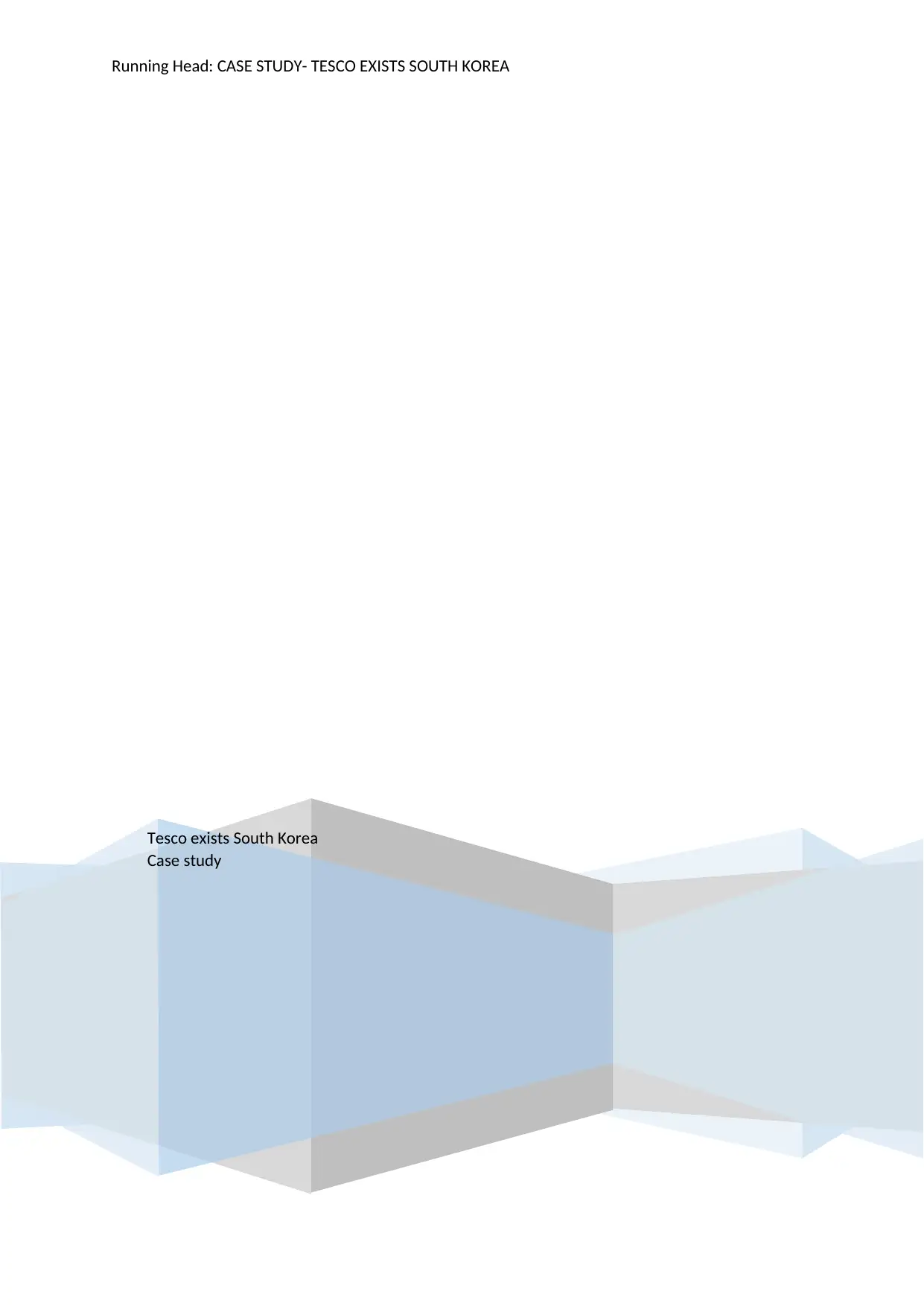
Running Head: CASE STUDY- TESCO EXISTS SOUTH KOREA
Tesco exists South Korea
Case study
Tesco exists South Korea
Case study
Secure Best Marks with AI Grader
Need help grading? Try our AI Grader for instant feedback on your assignments.
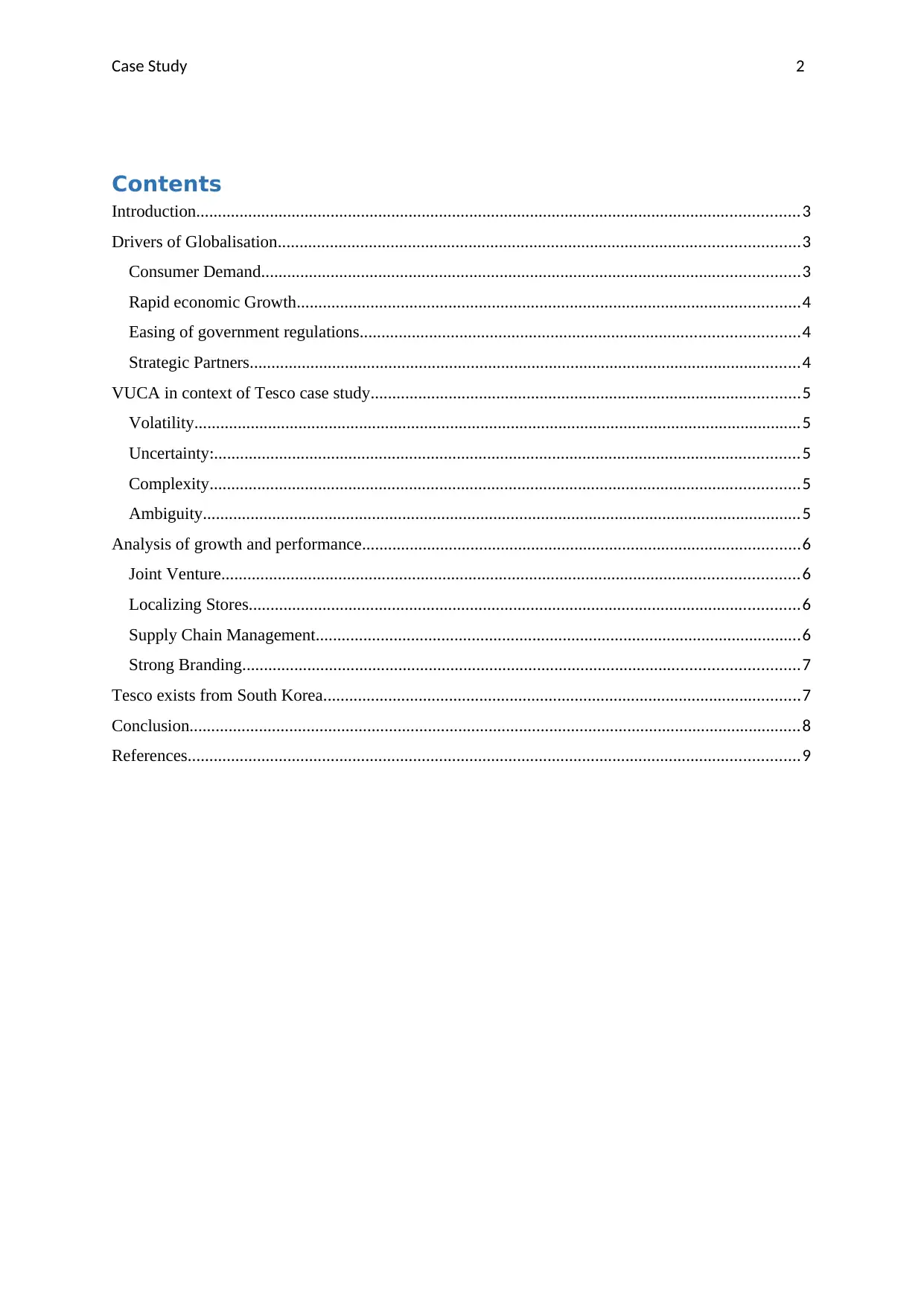
Case Study 2
Contents
Introduction...........................................................................................................................................3
Drivers of Globalisation........................................................................................................................3
Consumer Demand............................................................................................................................3
Rapid economic Growth....................................................................................................................4
Easing of government regulations.....................................................................................................4
Strategic Partners...............................................................................................................................4
VUCA in context of Tesco case study...................................................................................................5
Volatility............................................................................................................................................5
Uncertainty:.......................................................................................................................................5
Complexity........................................................................................................................................5
Ambiguity..........................................................................................................................................5
Analysis of growth and performance.....................................................................................................6
Joint Venture.....................................................................................................................................6
Localizing Stores...............................................................................................................................6
Supply Chain Management................................................................................................................6
Strong Branding................................................................................................................................7
Tesco exists from South Korea..............................................................................................................7
Conclusion.............................................................................................................................................8
References.............................................................................................................................................9
Contents
Introduction...........................................................................................................................................3
Drivers of Globalisation........................................................................................................................3
Consumer Demand............................................................................................................................3
Rapid economic Growth....................................................................................................................4
Easing of government regulations.....................................................................................................4
Strategic Partners...............................................................................................................................4
VUCA in context of Tesco case study...................................................................................................5
Volatility............................................................................................................................................5
Uncertainty:.......................................................................................................................................5
Complexity........................................................................................................................................5
Ambiguity..........................................................................................................................................5
Analysis of growth and performance.....................................................................................................6
Joint Venture.....................................................................................................................................6
Localizing Stores...............................................................................................................................6
Supply Chain Management................................................................................................................6
Strong Branding................................................................................................................................7
Tesco exists from South Korea..............................................................................................................7
Conclusion.............................................................................................................................................8
References.............................................................................................................................................9
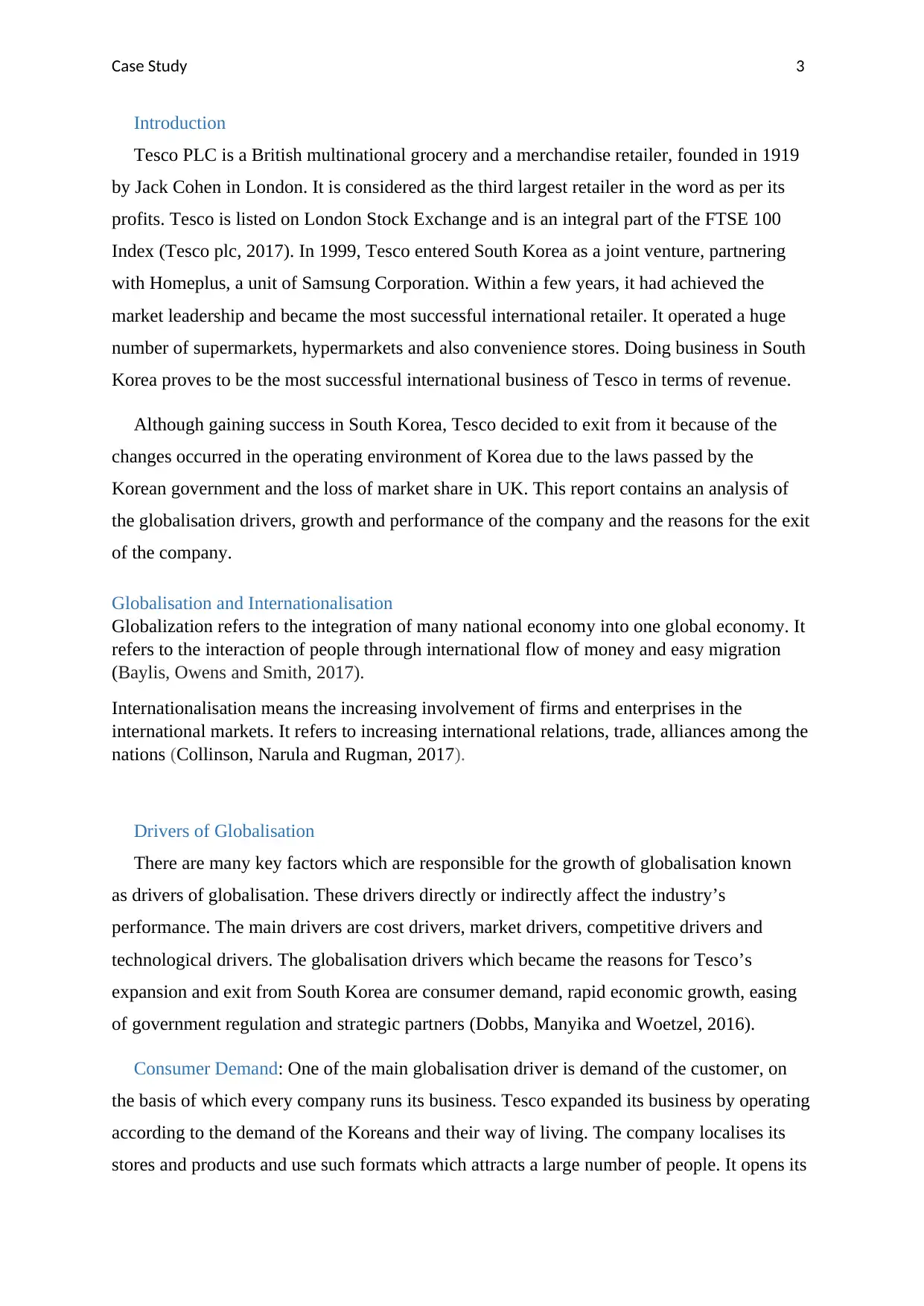
Case Study 3
Introduction
Tesco PLC is a British multinational grocery and a merchandise retailer, founded in 1919
by Jack Cohen in London. It is considered as the third largest retailer in the word as per its
profits. Tesco is listed on London Stock Exchange and is an integral part of the FTSE 100
Index (Tesco plc, 2017). In 1999, Tesco entered South Korea as a joint venture, partnering
with Homeplus, a unit of Samsung Corporation. Within a few years, it had achieved the
market leadership and became the most successful international retailer. It operated a huge
number of supermarkets, hypermarkets and also convenience stores. Doing business in South
Korea proves to be the most successful international business of Tesco in terms of revenue.
Although gaining success in South Korea, Tesco decided to exit from it because of the
changes occurred in the operating environment of Korea due to the laws passed by the
Korean government and the loss of market share in UK. This report contains an analysis of
the globalisation drivers, growth and performance of the company and the reasons for the exit
of the company.
Globalisation and Internationalisation
Globalization refers to the integration of many national economy into one global economy. It
refers to the interaction of people through international flow of money and easy migration
(Baylis, Owens and Smith, 2017).
Internationalisation means the increasing involvement of firms and enterprises in the
international markets. It refers to increasing international relations, trade, alliances among the
nations (Collinson, Narula and Rugman, 2017).
Drivers of Globalisation
There are many key factors which are responsible for the growth of globalisation known
as drivers of globalisation. These drivers directly or indirectly affect the industry’s
performance. The main drivers are cost drivers, market drivers, competitive drivers and
technological drivers. The globalisation drivers which became the reasons for Tesco’s
expansion and exit from South Korea are consumer demand, rapid economic growth, easing
of government regulation and strategic partners (Dobbs, Manyika and Woetzel, 2016).
Consumer Demand: One of the main globalisation driver is demand of the customer, on
the basis of which every company runs its business. Tesco expanded its business by operating
according to the demand of the Koreans and their way of living. The company localises its
stores and products and use such formats which attracts a large number of people. It opens its
Introduction
Tesco PLC is a British multinational grocery and a merchandise retailer, founded in 1919
by Jack Cohen in London. It is considered as the third largest retailer in the word as per its
profits. Tesco is listed on London Stock Exchange and is an integral part of the FTSE 100
Index (Tesco plc, 2017). In 1999, Tesco entered South Korea as a joint venture, partnering
with Homeplus, a unit of Samsung Corporation. Within a few years, it had achieved the
market leadership and became the most successful international retailer. It operated a huge
number of supermarkets, hypermarkets and also convenience stores. Doing business in South
Korea proves to be the most successful international business of Tesco in terms of revenue.
Although gaining success in South Korea, Tesco decided to exit from it because of the
changes occurred in the operating environment of Korea due to the laws passed by the
Korean government and the loss of market share in UK. This report contains an analysis of
the globalisation drivers, growth and performance of the company and the reasons for the exit
of the company.
Globalisation and Internationalisation
Globalization refers to the integration of many national economy into one global economy. It
refers to the interaction of people through international flow of money and easy migration
(Baylis, Owens and Smith, 2017).
Internationalisation means the increasing involvement of firms and enterprises in the
international markets. It refers to increasing international relations, trade, alliances among the
nations (Collinson, Narula and Rugman, 2017).
Drivers of Globalisation
There are many key factors which are responsible for the growth of globalisation known
as drivers of globalisation. These drivers directly or indirectly affect the industry’s
performance. The main drivers are cost drivers, market drivers, competitive drivers and
technological drivers. The globalisation drivers which became the reasons for Tesco’s
expansion and exit from South Korea are consumer demand, rapid economic growth, easing
of government regulation and strategic partners (Dobbs, Manyika and Woetzel, 2016).
Consumer Demand: One of the main globalisation driver is demand of the customer, on
the basis of which every company runs its business. Tesco expanded its business by operating
according to the demand of the Koreans and their way of living. The company localises its
stores and products and use such formats which attracts a large number of people. It opens its
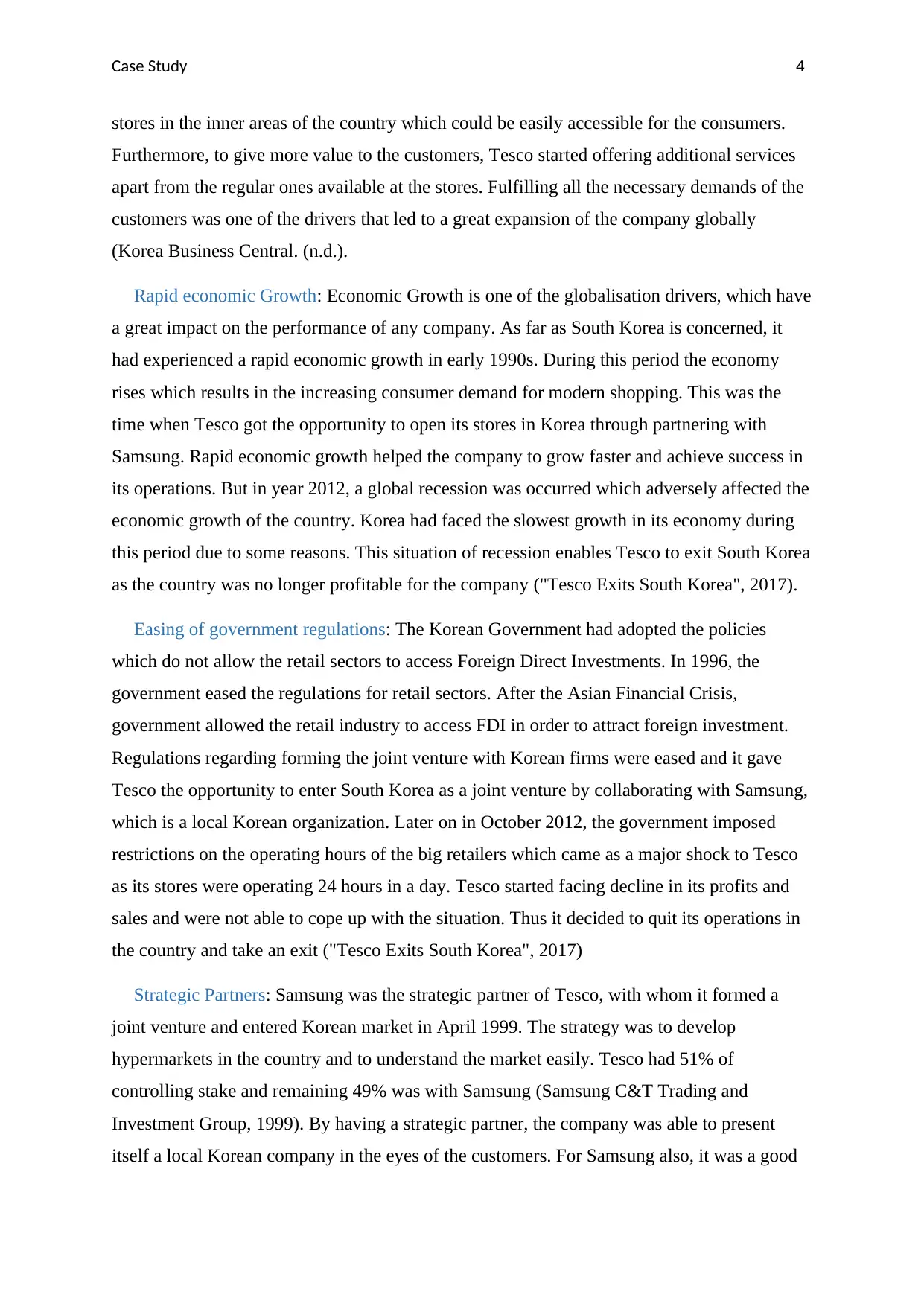
Case Study 4
stores in the inner areas of the country which could be easily accessible for the consumers.
Furthermore, to give more value to the customers, Tesco started offering additional services
apart from the regular ones available at the stores. Fulfilling all the necessary demands of the
customers was one of the drivers that led to a great expansion of the company globally
(Korea Business Central. (n.d.).
Rapid economic Growth: Economic Growth is one of the globalisation drivers, which have
a great impact on the performance of any company. As far as South Korea is concerned, it
had experienced a rapid economic growth in early 1990s. During this period the economy
rises which results in the increasing consumer demand for modern shopping. This was the
time when Tesco got the opportunity to open its stores in Korea through partnering with
Samsung. Rapid economic growth helped the company to grow faster and achieve success in
its operations. But in year 2012, a global recession was occurred which adversely affected the
economic growth of the country. Korea had faced the slowest growth in its economy during
this period due to some reasons. This situation of recession enables Tesco to exit South Korea
as the country was no longer profitable for the company ("Tesco Exits South Korea", 2017).
Easing of government regulations: The Korean Government had adopted the policies
which do not allow the retail sectors to access Foreign Direct Investments. In 1996, the
government eased the regulations for retail sectors. After the Asian Financial Crisis,
government allowed the retail industry to access FDI in order to attract foreign investment.
Regulations regarding forming the joint venture with Korean firms were eased and it gave
Tesco the opportunity to enter South Korea as a joint venture by collaborating with Samsung,
which is a local Korean organization. Later on in October 2012, the government imposed
restrictions on the operating hours of the big retailers which came as a major shock to Tesco
as its stores were operating 24 hours in a day. Tesco started facing decline in its profits and
sales and were not able to cope up with the situation. Thus it decided to quit its operations in
the country and take an exit ("Tesco Exits South Korea", 2017)
Strategic Partners: Samsung was the strategic partner of Tesco, with whom it formed a
joint venture and entered Korean market in April 1999. The strategy was to develop
hypermarkets in the country and to understand the market easily. Tesco had 51% of
controlling stake and remaining 49% was with Samsung (Samsung C&T Trading and
Investment Group, 1999). By having a strategic partner, the company was able to present
itself a local Korean company in the eyes of the customers. For Samsung also, it was a good
stores in the inner areas of the country which could be easily accessible for the consumers.
Furthermore, to give more value to the customers, Tesco started offering additional services
apart from the regular ones available at the stores. Fulfilling all the necessary demands of the
customers was one of the drivers that led to a great expansion of the company globally
(Korea Business Central. (n.d.).
Rapid economic Growth: Economic Growth is one of the globalisation drivers, which have
a great impact on the performance of any company. As far as South Korea is concerned, it
had experienced a rapid economic growth in early 1990s. During this period the economy
rises which results in the increasing consumer demand for modern shopping. This was the
time when Tesco got the opportunity to open its stores in Korea through partnering with
Samsung. Rapid economic growth helped the company to grow faster and achieve success in
its operations. But in year 2012, a global recession was occurred which adversely affected the
economic growth of the country. Korea had faced the slowest growth in its economy during
this period due to some reasons. This situation of recession enables Tesco to exit South Korea
as the country was no longer profitable for the company ("Tesco Exits South Korea", 2017).
Easing of government regulations: The Korean Government had adopted the policies
which do not allow the retail sectors to access Foreign Direct Investments. In 1996, the
government eased the regulations for retail sectors. After the Asian Financial Crisis,
government allowed the retail industry to access FDI in order to attract foreign investment.
Regulations regarding forming the joint venture with Korean firms were eased and it gave
Tesco the opportunity to enter South Korea as a joint venture by collaborating with Samsung,
which is a local Korean organization. Later on in October 2012, the government imposed
restrictions on the operating hours of the big retailers which came as a major shock to Tesco
as its stores were operating 24 hours in a day. Tesco started facing decline in its profits and
sales and were not able to cope up with the situation. Thus it decided to quit its operations in
the country and take an exit ("Tesco Exits South Korea", 2017)
Strategic Partners: Samsung was the strategic partner of Tesco, with whom it formed a
joint venture and entered Korean market in April 1999. The strategy was to develop
hypermarkets in the country and to understand the market easily. Tesco had 51% of
controlling stake and remaining 49% was with Samsung (Samsung C&T Trading and
Investment Group, 1999). By having a strategic partner, the company was able to present
itself a local Korean company in the eyes of the customers. For Samsung also, it was a good
Secure Best Marks with AI Grader
Need help grading? Try our AI Grader for instant feedback on your assignments.
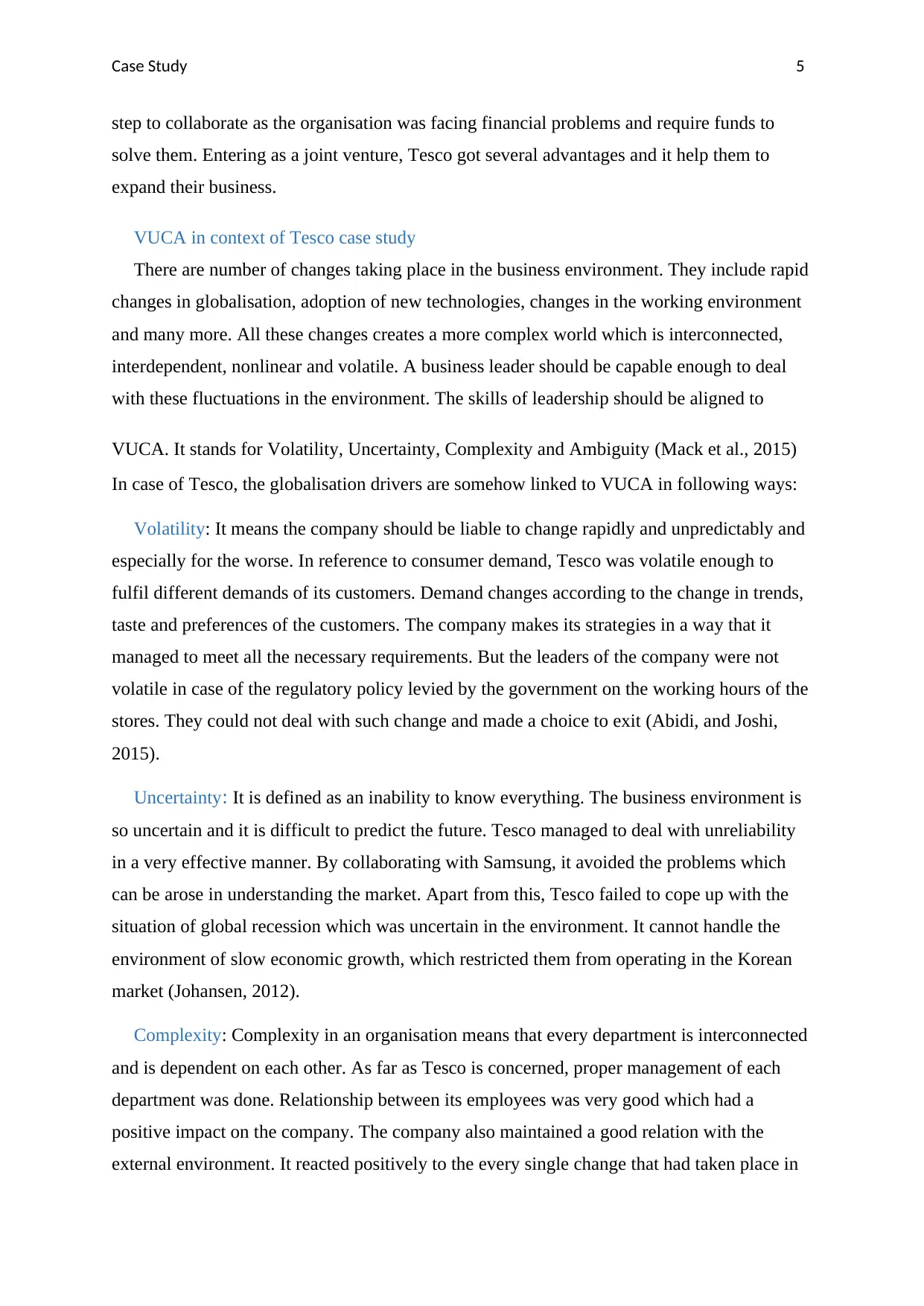
Case Study 5
step to collaborate as the organisation was facing financial problems and require funds to
solve them. Entering as a joint venture, Tesco got several advantages and it help them to
expand their business.
VUCA in context of Tesco case study
There are number of changes taking place in the business environment. They include rapid
changes in globalisation, adoption of new technologies, changes in the working environment
and many more. All these changes creates a more complex world which is interconnected,
interdependent, nonlinear and volatile. A business leader should be capable enough to deal
with these fluctuations in the environment. The skills of leadership should be aligned to
VUCA. It stands for Volatility, Uncertainty, Complexity and Ambiguity (Mack et al., 2015)
In case of Tesco, the globalisation drivers are somehow linked to VUCA in following ways:
Volatility: It means the company should be liable to change rapidly and unpredictably and
especially for the worse. In reference to consumer demand, Tesco was volatile enough to
fulfil different demands of its customers. Demand changes according to the change in trends,
taste and preferences of the customers. The company makes its strategies in a way that it
managed to meet all the necessary requirements. But the leaders of the company were not
volatile in case of the regulatory policy levied by the government on the working hours of the
stores. They could not deal with such change and made a choice to exit (Abidi, and Joshi,
2015).
Uncertainty: It is defined as an inability to know everything. The business environment is
so uncertain and it is difficult to predict the future. Tesco managed to deal with unreliability
in a very effective manner. By collaborating with Samsung, it avoided the problems which
can be arose in understanding the market. Apart from this, Tesco failed to cope up with the
situation of global recession which was uncertain in the environment. It cannot handle the
environment of slow economic growth, which restricted them from operating in the Korean
market (Johansen, 2012).
Complexity: Complexity in an organisation means that every department is interconnected
and is dependent on each other. As far as Tesco is concerned, proper management of each
department was done. Relationship between its employees was very good which had a
positive impact on the company. The company also maintained a good relation with the
external environment. It reacted positively to the every single change that had taken place in
step to collaborate as the organisation was facing financial problems and require funds to
solve them. Entering as a joint venture, Tesco got several advantages and it help them to
expand their business.
VUCA in context of Tesco case study
There are number of changes taking place in the business environment. They include rapid
changes in globalisation, adoption of new technologies, changes in the working environment
and many more. All these changes creates a more complex world which is interconnected,
interdependent, nonlinear and volatile. A business leader should be capable enough to deal
with these fluctuations in the environment. The skills of leadership should be aligned to
VUCA. It stands for Volatility, Uncertainty, Complexity and Ambiguity (Mack et al., 2015)
In case of Tesco, the globalisation drivers are somehow linked to VUCA in following ways:
Volatility: It means the company should be liable to change rapidly and unpredictably and
especially for the worse. In reference to consumer demand, Tesco was volatile enough to
fulfil different demands of its customers. Demand changes according to the change in trends,
taste and preferences of the customers. The company makes its strategies in a way that it
managed to meet all the necessary requirements. But the leaders of the company were not
volatile in case of the regulatory policy levied by the government on the working hours of the
stores. They could not deal with such change and made a choice to exit (Abidi, and Joshi,
2015).
Uncertainty: It is defined as an inability to know everything. The business environment is
so uncertain and it is difficult to predict the future. Tesco managed to deal with unreliability
in a very effective manner. By collaborating with Samsung, it avoided the problems which
can be arose in understanding the market. Apart from this, Tesco failed to cope up with the
situation of global recession which was uncertain in the environment. It cannot handle the
environment of slow economic growth, which restricted them from operating in the Korean
market (Johansen, 2012).
Complexity: Complexity in an organisation means that every department is interconnected
and is dependent on each other. As far as Tesco is concerned, proper management of each
department was done. Relationship between its employees was very good which had a
positive impact on the company. The company also maintained a good relation with the
external environment. It reacted positively to the every single change that had taken place in
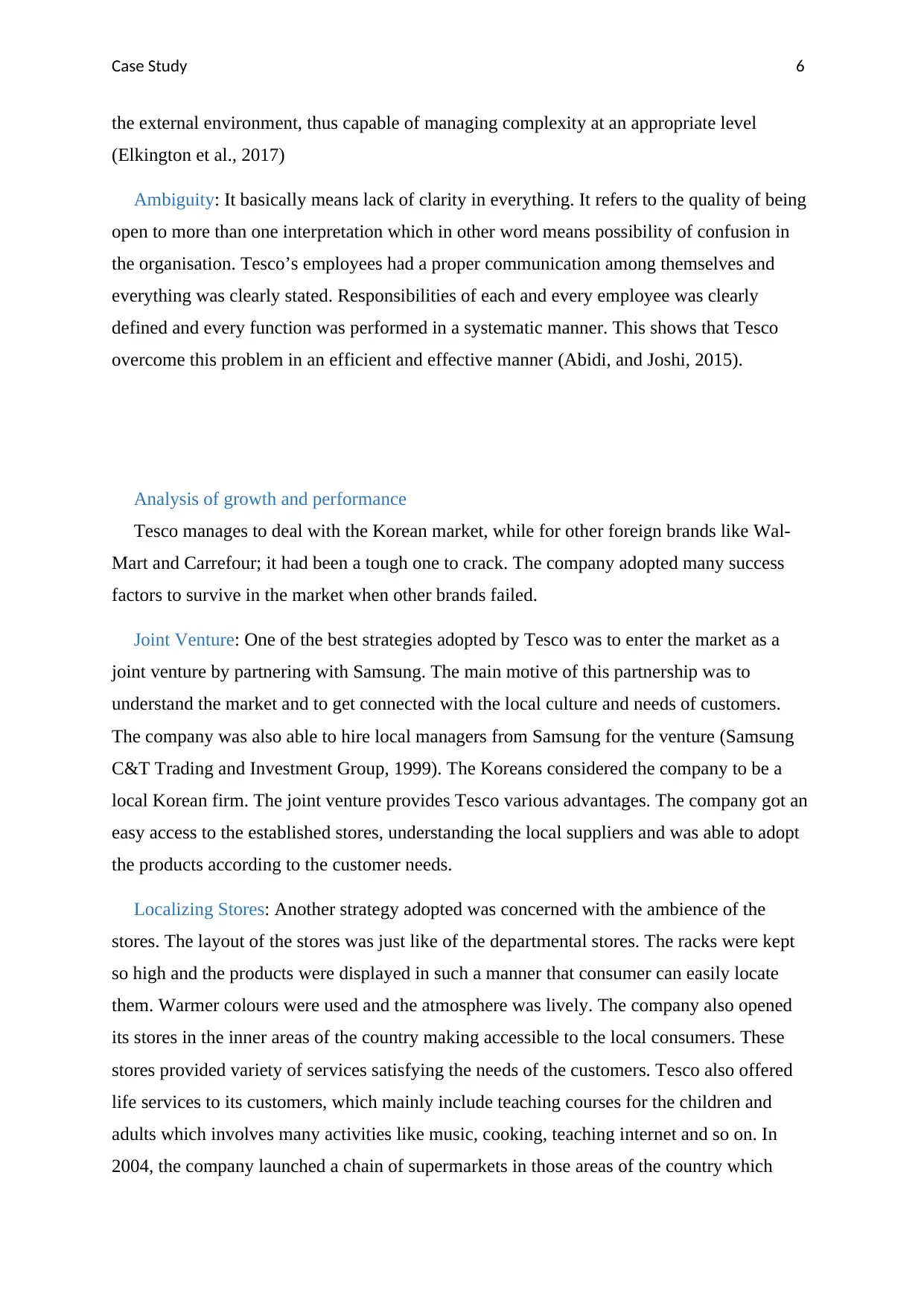
Case Study 6
the external environment, thus capable of managing complexity at an appropriate level
(Elkington et al., 2017)
Ambiguity: It basically means lack of clarity in everything. It refers to the quality of being
open to more than one interpretation which in other word means possibility of confusion in
the organisation. Tesco’s employees had a proper communication among themselves and
everything was clearly stated. Responsibilities of each and every employee was clearly
defined and every function was performed in a systematic manner. This shows that Tesco
overcome this problem in an efficient and effective manner (Abidi, and Joshi, 2015).
Analysis of growth and performance
Tesco manages to deal with the Korean market, while for other foreign brands like Wal-
Mart and Carrefour; it had been a tough one to crack. The company adopted many success
factors to survive in the market when other brands failed.
Joint Venture: One of the best strategies adopted by Tesco was to enter the market as a
joint venture by partnering with Samsung. The main motive of this partnership was to
understand the market and to get connected with the local culture and needs of customers.
The company was also able to hire local managers from Samsung for the venture (Samsung
C&T Trading and Investment Group, 1999). The Koreans considered the company to be a
local Korean firm. The joint venture provides Tesco various advantages. The company got an
easy access to the established stores, understanding the local suppliers and was able to adopt
the products according to the customer needs.
Localizing Stores: Another strategy adopted was concerned with the ambience of the
stores. The layout of the stores was just like of the departmental stores. The racks were kept
so high and the products were displayed in such a manner that consumer can easily locate
them. Warmer colours were used and the atmosphere was lively. The company also opened
its stores in the inner areas of the country making accessible to the local consumers. These
stores provided variety of services satisfying the needs of the customers. Tesco also offered
life services to its customers, which mainly include teaching courses for the children and
adults which involves many activities like music, cooking, teaching internet and so on. In
2004, the company launched a chain of supermarkets in those areas of the country which
the external environment, thus capable of managing complexity at an appropriate level
(Elkington et al., 2017)
Ambiguity: It basically means lack of clarity in everything. It refers to the quality of being
open to more than one interpretation which in other word means possibility of confusion in
the organisation. Tesco’s employees had a proper communication among themselves and
everything was clearly stated. Responsibilities of each and every employee was clearly
defined and every function was performed in a systematic manner. This shows that Tesco
overcome this problem in an efficient and effective manner (Abidi, and Joshi, 2015).
Analysis of growth and performance
Tesco manages to deal with the Korean market, while for other foreign brands like Wal-
Mart and Carrefour; it had been a tough one to crack. The company adopted many success
factors to survive in the market when other brands failed.
Joint Venture: One of the best strategies adopted by Tesco was to enter the market as a
joint venture by partnering with Samsung. The main motive of this partnership was to
understand the market and to get connected with the local culture and needs of customers.
The company was also able to hire local managers from Samsung for the venture (Samsung
C&T Trading and Investment Group, 1999). The Koreans considered the company to be a
local Korean firm. The joint venture provides Tesco various advantages. The company got an
easy access to the established stores, understanding the local suppliers and was able to adopt
the products according to the customer needs.
Localizing Stores: Another strategy adopted was concerned with the ambience of the
stores. The layout of the stores was just like of the departmental stores. The racks were kept
so high and the products were displayed in such a manner that consumer can easily locate
them. Warmer colours were used and the atmosphere was lively. The company also opened
its stores in the inner areas of the country making accessible to the local consumers. These
stores provided variety of services satisfying the needs of the customers. Tesco also offered
life services to its customers, which mainly include teaching courses for the children and
adults which involves many activities like music, cooking, teaching internet and so on. In
2004, the company launched a chain of supermarkets in those areas of the country which
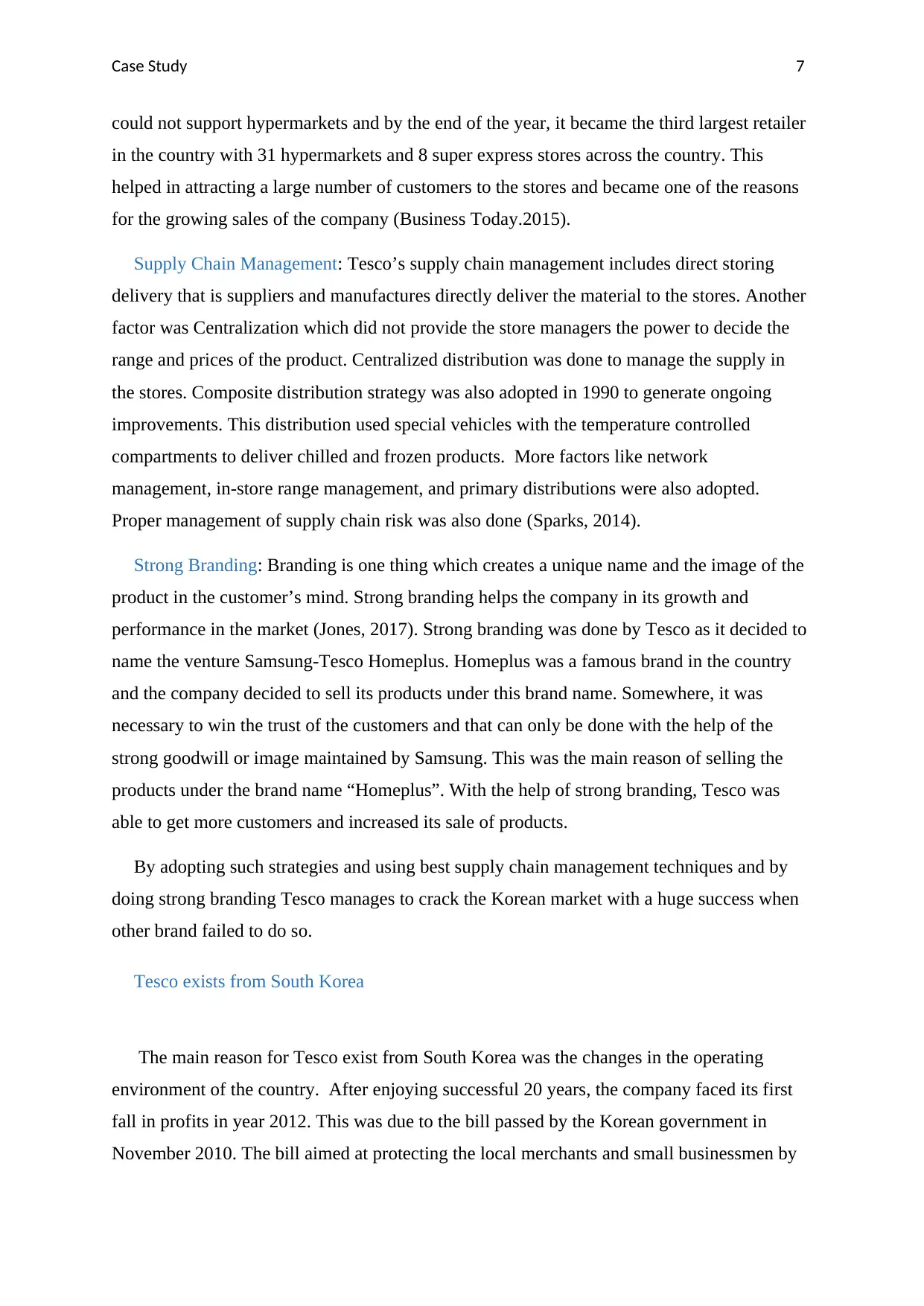
Case Study 7
could not support hypermarkets and by the end of the year, it became the third largest retailer
in the country with 31 hypermarkets and 8 super express stores across the country. This
helped in attracting a large number of customers to the stores and became one of the reasons
for the growing sales of the company (Business Today.2015).
Supply Chain Management: Tesco’s supply chain management includes direct storing
delivery that is suppliers and manufactures directly deliver the material to the stores. Another
factor was Centralization which did not provide the store managers the power to decide the
range and prices of the product. Centralized distribution was done to manage the supply in
the stores. Composite distribution strategy was also adopted in 1990 to generate ongoing
improvements. This distribution used special vehicles with the temperature controlled
compartments to deliver chilled and frozen products. More factors like network
management, in-store range management, and primary distributions were also adopted.
Proper management of supply chain risk was also done (Sparks, 2014).
Strong Branding: Branding is one thing which creates a unique name and the image of the
product in the customer’s mind. Strong branding helps the company in its growth and
performance in the market (Jones, 2017). Strong branding was done by Tesco as it decided to
name the venture Samsung-Tesco Homeplus. Homeplus was a famous brand in the country
and the company decided to sell its products under this brand name. Somewhere, it was
necessary to win the trust of the customers and that can only be done with the help of the
strong goodwill or image maintained by Samsung. This was the main reason of selling the
products under the brand name “Homeplus”. With the help of strong branding, Tesco was
able to get more customers and increased its sale of products.
By adopting such strategies and using best supply chain management techniques and by
doing strong branding Tesco manages to crack the Korean market with a huge success when
other brand failed to do so.
Tesco exists from South Korea
The main reason for Tesco exist from South Korea was the changes in the operating
environment of the country. After enjoying successful 20 years, the company faced its first
fall in profits in year 2012. This was due to the bill passed by the Korean government in
November 2010. The bill aimed at protecting the local merchants and small businessmen by
could not support hypermarkets and by the end of the year, it became the third largest retailer
in the country with 31 hypermarkets and 8 super express stores across the country. This
helped in attracting a large number of customers to the stores and became one of the reasons
for the growing sales of the company (Business Today.2015).
Supply Chain Management: Tesco’s supply chain management includes direct storing
delivery that is suppliers and manufactures directly deliver the material to the stores. Another
factor was Centralization which did not provide the store managers the power to decide the
range and prices of the product. Centralized distribution was done to manage the supply in
the stores. Composite distribution strategy was also adopted in 1990 to generate ongoing
improvements. This distribution used special vehicles with the temperature controlled
compartments to deliver chilled and frozen products. More factors like network
management, in-store range management, and primary distributions were also adopted.
Proper management of supply chain risk was also done (Sparks, 2014).
Strong Branding: Branding is one thing which creates a unique name and the image of the
product in the customer’s mind. Strong branding helps the company in its growth and
performance in the market (Jones, 2017). Strong branding was done by Tesco as it decided to
name the venture Samsung-Tesco Homeplus. Homeplus was a famous brand in the country
and the company decided to sell its products under this brand name. Somewhere, it was
necessary to win the trust of the customers and that can only be done with the help of the
strong goodwill or image maintained by Samsung. This was the main reason of selling the
products under the brand name “Homeplus”. With the help of strong branding, Tesco was
able to get more customers and increased its sale of products.
By adopting such strategies and using best supply chain management techniques and by
doing strong branding Tesco manages to crack the Korean market with a huge success when
other brand failed to do so.
Tesco exists from South Korea
The main reason for Tesco exist from South Korea was the changes in the operating
environment of the country. After enjoying successful 20 years, the company faced its first
fall in profits in year 2012. This was due to the bill passed by the Korean government in
November 2010. The bill aimed at protecting the local merchants and small businessmen by
Paraphrase This Document
Need a fresh take? Get an instant paraphrase of this document with our AI Paraphraser
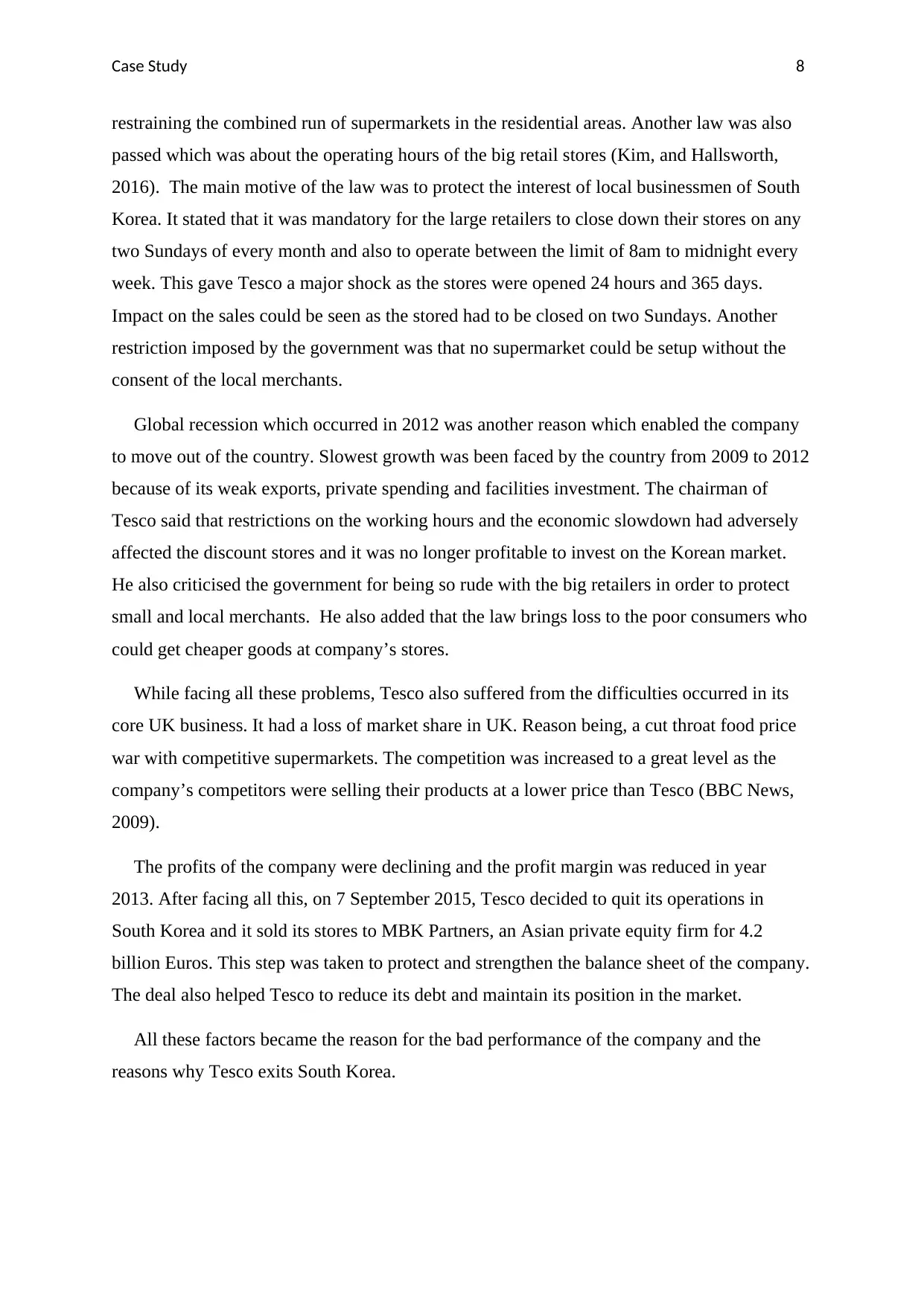
Case Study 8
restraining the combined run of supermarkets in the residential areas. Another law was also
passed which was about the operating hours of the big retail stores (Kim, and Hallsworth,
2016). The main motive of the law was to protect the interest of local businessmen of South
Korea. It stated that it was mandatory for the large retailers to close down their stores on any
two Sundays of every month and also to operate between the limit of 8am to midnight every
week. This gave Tesco a major shock as the stores were opened 24 hours and 365 days.
Impact on the sales could be seen as the stored had to be closed on two Sundays. Another
restriction imposed by the government was that no supermarket could be setup without the
consent of the local merchants.
Global recession which occurred in 2012 was another reason which enabled the company
to move out of the country. Slowest growth was been faced by the country from 2009 to 2012
because of its weak exports, private spending and facilities investment. The chairman of
Tesco said that restrictions on the working hours and the economic slowdown had adversely
affected the discount stores and it was no longer profitable to invest on the Korean market.
He also criticised the government for being so rude with the big retailers in order to protect
small and local merchants. He also added that the law brings loss to the poor consumers who
could get cheaper goods at company’s stores.
While facing all these problems, Tesco also suffered from the difficulties occurred in its
core UK business. It had a loss of market share in UK. Reason being, a cut throat food price
war with competitive supermarkets. The competition was increased to a great level as the
company’s competitors were selling their products at a lower price than Tesco (BBC News,
2009).
The profits of the company were declining and the profit margin was reduced in year
2013. After facing all this, on 7 September 2015, Tesco decided to quit its operations in
South Korea and it sold its stores to MBK Partners, an Asian private equity firm for 4.2
billion Euros. This step was taken to protect and strengthen the balance sheet of the company.
The deal also helped Tesco to reduce its debt and maintain its position in the market.
All these factors became the reason for the bad performance of the company and the
reasons why Tesco exits South Korea.
restraining the combined run of supermarkets in the residential areas. Another law was also
passed which was about the operating hours of the big retail stores (Kim, and Hallsworth,
2016). The main motive of the law was to protect the interest of local businessmen of South
Korea. It stated that it was mandatory for the large retailers to close down their stores on any
two Sundays of every month and also to operate between the limit of 8am to midnight every
week. This gave Tesco a major shock as the stores were opened 24 hours and 365 days.
Impact on the sales could be seen as the stored had to be closed on two Sundays. Another
restriction imposed by the government was that no supermarket could be setup without the
consent of the local merchants.
Global recession which occurred in 2012 was another reason which enabled the company
to move out of the country. Slowest growth was been faced by the country from 2009 to 2012
because of its weak exports, private spending and facilities investment. The chairman of
Tesco said that restrictions on the working hours and the economic slowdown had adversely
affected the discount stores and it was no longer profitable to invest on the Korean market.
He also criticised the government for being so rude with the big retailers in order to protect
small and local merchants. He also added that the law brings loss to the poor consumers who
could get cheaper goods at company’s stores.
While facing all these problems, Tesco also suffered from the difficulties occurred in its
core UK business. It had a loss of market share in UK. Reason being, a cut throat food price
war with competitive supermarkets. The competition was increased to a great level as the
company’s competitors were selling their products at a lower price than Tesco (BBC News,
2009).
The profits of the company were declining and the profit margin was reduced in year
2013. After facing all this, on 7 September 2015, Tesco decided to quit its operations in
South Korea and it sold its stores to MBK Partners, an Asian private equity firm for 4.2
billion Euros. This step was taken to protect and strengthen the balance sheet of the company.
The deal also helped Tesco to reduce its debt and maintain its position in the market.
All these factors became the reason for the bad performance of the company and the
reasons why Tesco exits South Korea.
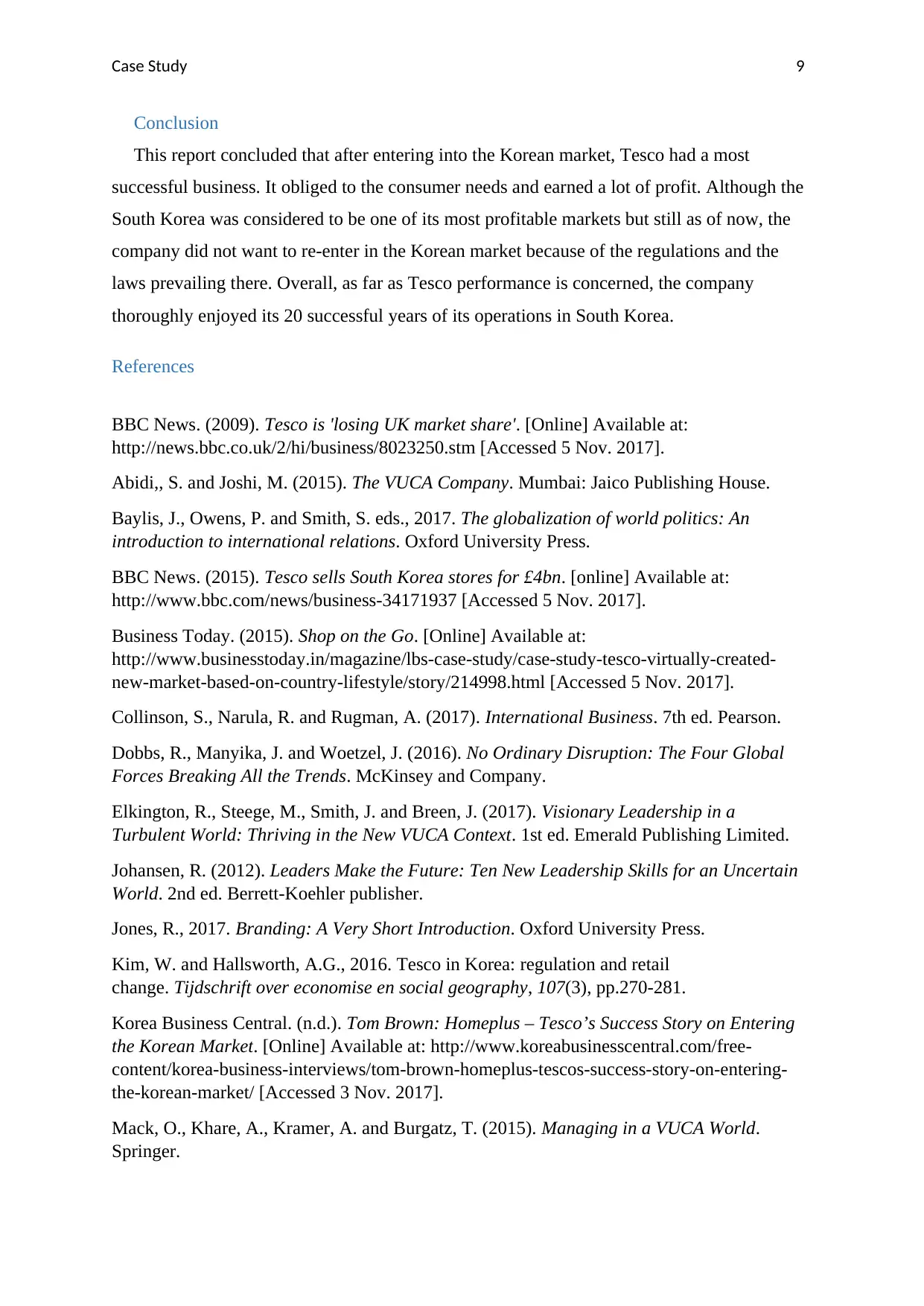
Case Study 9
Conclusion
This report concluded that after entering into the Korean market, Tesco had a most
successful business. It obliged to the consumer needs and earned a lot of profit. Although the
South Korea was considered to be one of its most profitable markets but still as of now, the
company did not want to re-enter in the Korean market because of the regulations and the
laws prevailing there. Overall, as far as Tesco performance is concerned, the company
thoroughly enjoyed its 20 successful years of its operations in South Korea.
References
BBC News. (2009). Tesco is 'losing UK market share'. [Online] Available at:
http://news.bbc.co.uk/2/hi/business/8023250.stm [Accessed 5 Nov. 2017].
Abidi,, S. and Joshi, M. (2015). The VUCA Company. Mumbai: Jaico Publishing House.
Baylis, J., Owens, P. and Smith, S. eds., 2017. The globalization of world politics: An
introduction to international relations. Oxford University Press.
BBC News. (2015). Tesco sells South Korea stores for £4bn. [online] Available at:
http://www.bbc.com/news/business-34171937 [Accessed 5 Nov. 2017].
Business Today. (2015). Shop on the Go. [Online] Available at:
http://www.businesstoday.in/magazine/lbs-case-study/case-study-tesco-virtually-created-
new-market-based-on-country-lifestyle/story/214998.html [Accessed 5 Nov. 2017].
Collinson, S., Narula, R. and Rugman, A. (2017). International Business. 7th ed. Pearson.
Dobbs, R., Manyika, J. and Woetzel, J. (2016). No Ordinary Disruption: The Four Global
Forces Breaking All the Trends. McKinsey and Company.
Elkington, R., Steege, M., Smith, J. and Breen, J. (2017). Visionary Leadership in a
Turbulent World: Thriving in the New VUCA Context. 1st ed. Emerald Publishing Limited.
Johansen, R. (2012). Leaders Make the Future: Ten New Leadership Skills for an Uncertain
World. 2nd ed. Berrett-Koehler publisher.
Jones, R., 2017. Branding: A Very Short Introduction. Oxford University Press.
Kim, W. and Hallsworth, A.G., 2016. Tesco in Korea: regulation and retail
change. Tijdschrift over economise en social geography, 107(3), pp.270-281.
Korea Business Central. (n.d.). Tom Brown: Homeplus – Tesco’s Success Story on Entering
the Korean Market. [Online] Available at: http://www.koreabusinesscentral.com/free-
content/korea-business-interviews/tom-brown-homeplus-tescos-success-story-on-entering-
the-korean-market/ [Accessed 3 Nov. 2017].
Mack, O., Khare, A., Kramer, A. and Burgatz, T. (2015). Managing in a VUCA World.
Springer.
Conclusion
This report concluded that after entering into the Korean market, Tesco had a most
successful business. It obliged to the consumer needs and earned a lot of profit. Although the
South Korea was considered to be one of its most profitable markets but still as of now, the
company did not want to re-enter in the Korean market because of the regulations and the
laws prevailing there. Overall, as far as Tesco performance is concerned, the company
thoroughly enjoyed its 20 successful years of its operations in South Korea.
References
BBC News. (2009). Tesco is 'losing UK market share'. [Online] Available at:
http://news.bbc.co.uk/2/hi/business/8023250.stm [Accessed 5 Nov. 2017].
Abidi,, S. and Joshi, M. (2015). The VUCA Company. Mumbai: Jaico Publishing House.
Baylis, J., Owens, P. and Smith, S. eds., 2017. The globalization of world politics: An
introduction to international relations. Oxford University Press.
BBC News. (2015). Tesco sells South Korea stores for £4bn. [online] Available at:
http://www.bbc.com/news/business-34171937 [Accessed 5 Nov. 2017].
Business Today. (2015). Shop on the Go. [Online] Available at:
http://www.businesstoday.in/magazine/lbs-case-study/case-study-tesco-virtually-created-
new-market-based-on-country-lifestyle/story/214998.html [Accessed 5 Nov. 2017].
Collinson, S., Narula, R. and Rugman, A. (2017). International Business. 7th ed. Pearson.
Dobbs, R., Manyika, J. and Woetzel, J. (2016). No Ordinary Disruption: The Four Global
Forces Breaking All the Trends. McKinsey and Company.
Elkington, R., Steege, M., Smith, J. and Breen, J. (2017). Visionary Leadership in a
Turbulent World: Thriving in the New VUCA Context. 1st ed. Emerald Publishing Limited.
Johansen, R. (2012). Leaders Make the Future: Ten New Leadership Skills for an Uncertain
World. 2nd ed. Berrett-Koehler publisher.
Jones, R., 2017. Branding: A Very Short Introduction. Oxford University Press.
Kim, W. and Hallsworth, A.G., 2016. Tesco in Korea: regulation and retail
change. Tijdschrift over economise en social geography, 107(3), pp.270-281.
Korea Business Central. (n.d.). Tom Brown: Homeplus – Tesco’s Success Story on Entering
the Korean Market. [Online] Available at: http://www.koreabusinesscentral.com/free-
content/korea-business-interviews/tom-brown-homeplus-tescos-success-story-on-entering-
the-korean-market/ [Accessed 3 Nov. 2017].
Mack, O., Khare, A., Kramer, A. and Burgatz, T. (2015). Managing in a VUCA World.
Springer.
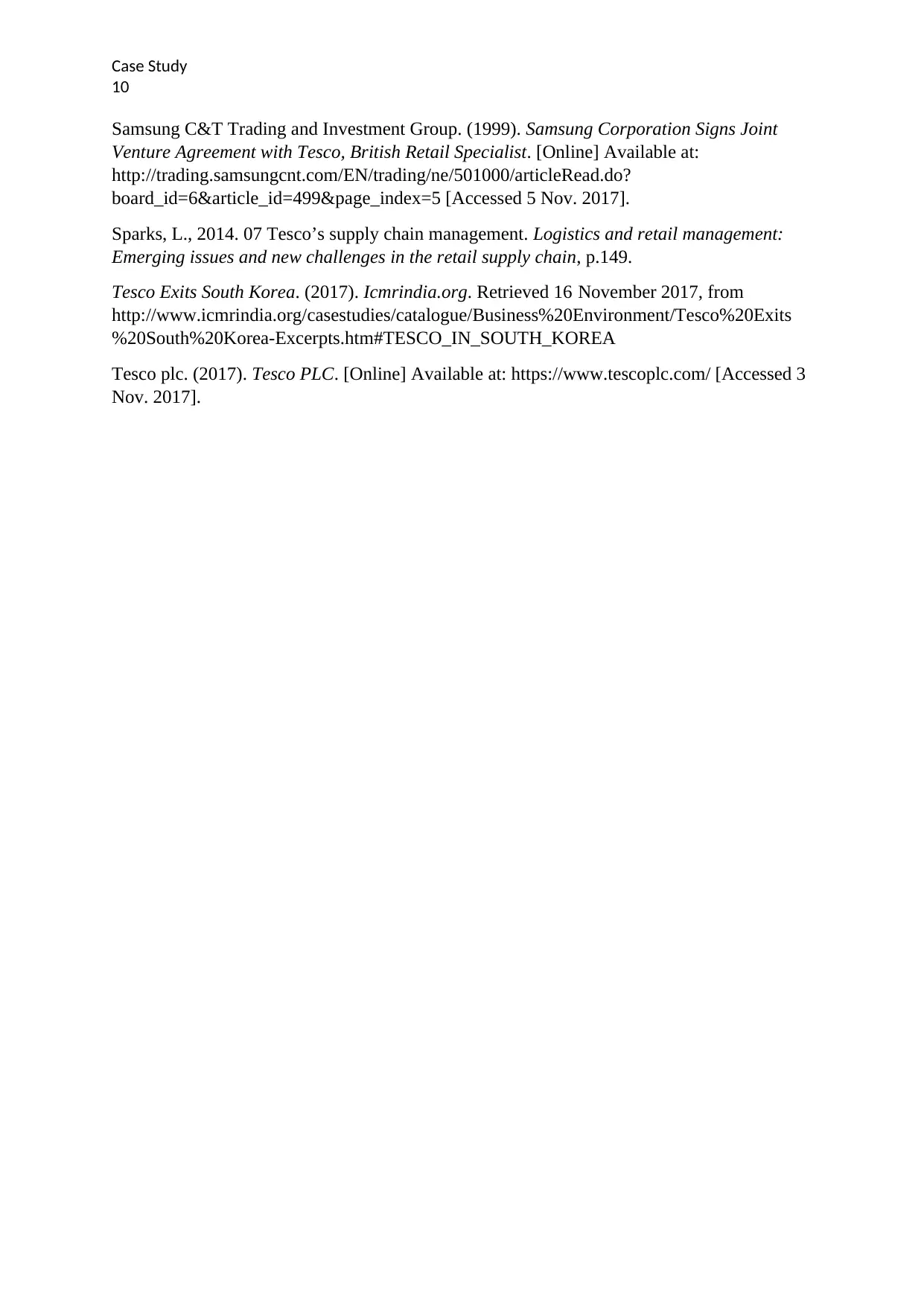
Case Study
10
Samsung C&T Trading and Investment Group. (1999). Samsung Corporation Signs Joint
Venture Agreement with Tesco, British Retail Specialist. [Online] Available at:
http://trading.samsungcnt.com/EN/trading/ne/501000/articleRead.do?
board_id=6&article_id=499&page_index=5 [Accessed 5 Nov. 2017].
Sparks, L., 2014. 07 Tesco’s supply chain management. Logistics and retail management:
Emerging issues and new challenges in the retail supply chain, p.149.
Tesco Exits South Korea. (2017). Icmrindia.org. Retrieved 16 November 2017, from
http://www.icmrindia.org/casestudies/catalogue/Business%20Environment/Tesco%20Exits
%20South%20Korea-Excerpts.htm#TESCO_IN_SOUTH_KOREA
Tesco plc. (2017). Tesco PLC. [Online] Available at: https://www.tescoplc.com/ [Accessed 3
Nov. 2017].
10
Samsung C&T Trading and Investment Group. (1999). Samsung Corporation Signs Joint
Venture Agreement with Tesco, British Retail Specialist. [Online] Available at:
http://trading.samsungcnt.com/EN/trading/ne/501000/articleRead.do?
board_id=6&article_id=499&page_index=5 [Accessed 5 Nov. 2017].
Sparks, L., 2014. 07 Tesco’s supply chain management. Logistics and retail management:
Emerging issues and new challenges in the retail supply chain, p.149.
Tesco Exits South Korea. (2017). Icmrindia.org. Retrieved 16 November 2017, from
http://www.icmrindia.org/casestudies/catalogue/Business%20Environment/Tesco%20Exits
%20South%20Korea-Excerpts.htm#TESCO_IN_SOUTH_KOREA
Tesco plc. (2017). Tesco PLC. [Online] Available at: https://www.tescoplc.com/ [Accessed 3
Nov. 2017].
1 out of 10
Related Documents
Your All-in-One AI-Powered Toolkit for Academic Success.
+13062052269
info@desklib.com
Available 24*7 on WhatsApp / Email
![[object Object]](/_next/static/media/star-bottom.7253800d.svg)
Unlock your academic potential
© 2024 | Zucol Services PVT LTD | All rights reserved.





